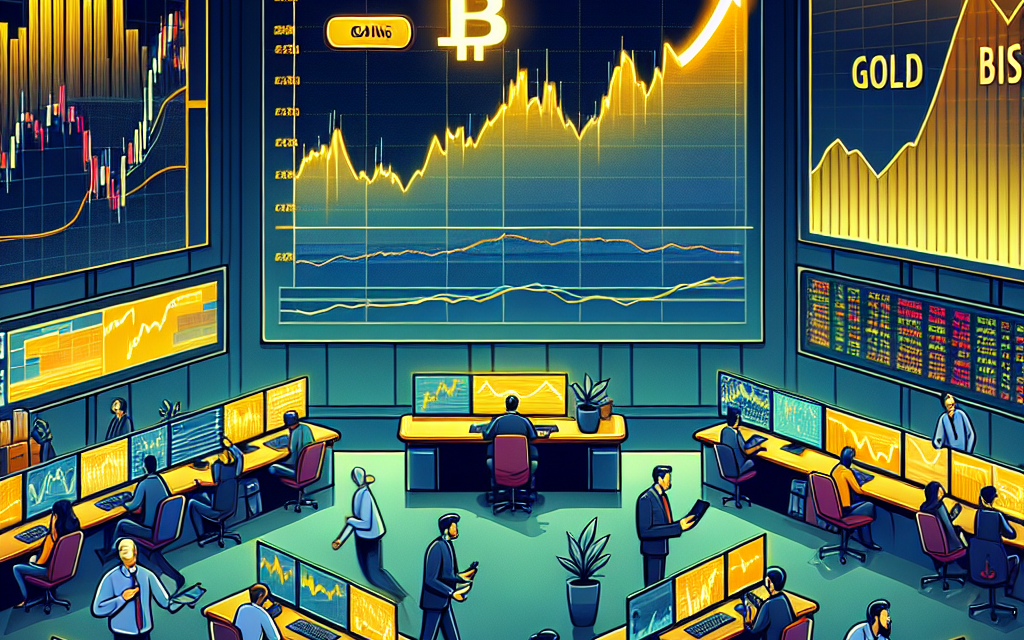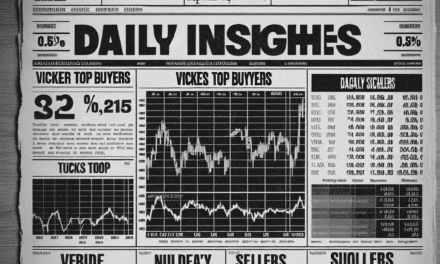“Market Waves: Stocks Sway, Gold Glimmers, Bitcoin Breaks $90K Barrier”
Introduction
In the latest financial markets update, investors are witnessing a dynamic landscape as stock markets experience fluctuations, reflecting a mix of economic indicators and investor sentiment. Meanwhile, gold is seeing gains, driven by its traditional role as a safe-haven asset amid market uncertainties. In the cryptocurrency realm, Bitcoin has made headlines by surpassing the $90,000 mark, showcasing its continued volatility and appeal to investors seeking alternative assets. These developments highlight the diverse factors influencing global markets and the strategic decisions investors face in navigating this complex environment.
Stock Market Volatility: Analyzing the Recent Fluctuations
In recent weeks, the stock market has experienced notable fluctuations, capturing the attention of investors and analysts alike. This volatility can be attributed to a confluence of factors, each contributing to the unpredictable nature of the market. As investors navigate these turbulent waters, it is essential to understand the underlying causes of these fluctuations and their potential implications for the future.
One of the primary drivers of recent stock market volatility is the ongoing uncertainty surrounding global economic conditions. With inflation rates remaining persistently high in many regions, central banks have been compelled to adopt more aggressive monetary policies. Interest rate hikes, intended to curb inflation, have inadvertently introduced a level of unpredictability into the market. Investors, wary of the potential impact of these rate increases on corporate profits and consumer spending, have reacted by adjusting their portfolios, leading to increased market volatility.
Moreover, geopolitical tensions have further exacerbated market fluctuations. The ongoing conflict in Eastern Europe, coupled with trade disputes between major economies, has created an environment of uncertainty. Investors are particularly concerned about the potential for supply chain disruptions and their impact on global trade. As a result, market participants have been quick to react to any news or developments in these areas, contributing to the erratic behavior of stock prices.
In contrast to the stock market’s volatility, gold has emerged as a beacon of stability. Traditionally viewed as a safe-haven asset, gold has seen gains as investors seek refuge from the uncertainty plaguing other markets. The precious metal’s appeal is further bolstered by its historical performance during times of economic turmoil. As inflationary pressures persist and geopolitical tensions remain unresolved, gold’s allure is likely to endure, providing a measure of security for risk-averse investors.
Meanwhile, in the realm of digital assets, Bitcoin has surpassed the $90,000 mark, marking a significant milestone in its volatile journey. This surge can be attributed to a growing acceptance of cryptocurrencies as legitimate investment vehicles. Institutional investors, once skeptical of digital currencies, have increasingly embraced Bitcoin, recognizing its potential as a hedge against inflation and currency devaluation. Additionally, advancements in blockchain technology and regulatory clarity in certain jurisdictions have contributed to the growing confidence in Bitcoin’s long-term viability.
However, it is important to note that Bitcoin’s ascent is not without its challenges. The cryptocurrency market remains highly speculative, with prices subject to rapid and unpredictable swings. Regulatory scrutiny, security concerns, and technological hurdles continue to pose risks to Bitcoin’s sustained growth. Nevertheless, the recent surge past $90,000 underscores the evolving landscape of digital assets and their growing significance in the broader financial ecosystem.
In conclusion, the recent fluctuations in the stock market, coupled with the gains in gold and Bitcoin, highlight the complex interplay of economic, geopolitical, and technological factors shaping today’s financial landscape. As investors grapple with these dynamics, a nuanced understanding of the underlying causes and potential implications is crucial. While uncertainty remains a defining feature of the current market environment, opportunities for growth and stability persist for those who navigate these challenges with informed strategies and a keen awareness of the evolving trends.
Gold’s Resurgence: Factors Driving the Precious Metal’s Gains
In recent months, the financial markets have witnessed a series of dynamic shifts, with stocks experiencing fluctuations, Bitcoin surpassing the $90,000 mark, and gold making notable gains. Among these developments, the resurgence of gold has captured the attention of investors and analysts alike. This renewed interest in the precious metal can be attributed to a confluence of factors that have collectively driven its value upward.
To begin with, economic uncertainty has played a pivotal role in bolstering gold’s appeal. As global markets grapple with the lingering effects of the pandemic, geopolitical tensions, and inflationary pressures, investors have increasingly sought safe-haven assets to mitigate risk. Gold, historically regarded as a reliable store of value during turbulent times, has naturally benefited from this shift in investor sentiment. The metal’s intrinsic value and limited supply make it an attractive option for those looking to preserve wealth amidst economic volatility.
Moreover, inflation concerns have further fueled gold’s ascent. With central banks around the world implementing expansive monetary policies to stimulate growth, fears of rising inflation have become more pronounced. In such an environment, gold is often perceived as a hedge against inflation, as its value tends to rise when the purchasing power of fiat currencies declines. This perception has led to increased demand for gold, as investors seek to protect their portfolios from the erosive effects of inflation.
In addition to these macroeconomic factors, changes in interest rates have also influenced gold’s performance. As central banks navigate the delicate balance between supporting economic recovery and curbing inflation, interest rate policies have come under scrutiny. Lower interest rates generally reduce the opportunity cost of holding non-yielding assets like gold, making it a more attractive investment. Consequently, any indication of prolonged low interest rates has the potential to drive further interest in gold, as investors look to capitalize on its relative stability.
Furthermore, the weakening of the US dollar has contributed to gold’s resurgence. As the world’s primary reserve currency, fluctuations in the dollar’s value can have significant implications for commodities priced in dollars, including gold. A weaker dollar makes gold more affordable for investors holding other currencies, thereby boosting demand. This inverse relationship between the dollar and gold has been a key factor in the metal’s recent gains, as the dollar has faced downward pressure from various economic and policy developments.
Additionally, technological advancements and increased accessibility have played a role in gold’s renewed popularity. The rise of digital platforms and exchange-traded funds (ETFs) has made it easier for investors to gain exposure to gold without the need to physically hold the metal. This increased accessibility has broadened the investor base, allowing more individuals and institutions to participate in the gold market. As a result, the demand for gold has been bolstered by a more diverse range of market participants.
In conclusion, the resurgence of gold can be attributed to a combination of economic uncertainty, inflation concerns, interest rate dynamics, currency fluctuations, and technological advancements. As these factors continue to evolve, gold’s role as a safe-haven asset and a hedge against inflation is likely to remain prominent in the minds of investors. While the future trajectory of gold prices remains uncertain, the current environment suggests that the precious metal will continue to play a significant role in the global financial landscape.
Bitcoin’s Milestone: Implications of Surpassing $90,000
As Bitcoin surpasses the $90,000 mark, the implications of this milestone are multifaceted, reflecting both the evolving landscape of digital currencies and the broader economic environment. This achievement underscores the growing acceptance and integration of cryptocurrencies into mainstream financial systems. The surge in Bitcoin’s value can be attributed to a confluence of factors, including increased institutional investment, heightened interest from retail investors, and a global economic climate that has driven individuals and institutions alike to seek alternative stores of value.
Institutional investment has played a pivotal role in Bitcoin’s ascent. Over the past few years, major financial institutions and corporations have increasingly embraced Bitcoin, either by directly investing in the cryptocurrency or by offering Bitcoin-related services to their clients. This institutional endorsement has not only lent credibility to Bitcoin but has also contributed to its price stability and growth. As more institutions allocate a portion of their portfolios to Bitcoin, the demand for the cryptocurrency continues to rise, driving its price upward.
Moreover, the interest from retail investors cannot be overlooked. The democratization of investment through platforms that offer easy access to cryptocurrencies has empowered individual investors to participate in the market. This democratization has been further fueled by social media and online communities, where information and investment strategies are shared widely, creating a groundswell of interest and participation in Bitcoin trading. Consequently, this has led to increased liquidity and trading volumes, further supporting Bitcoin’s price trajectory.
In addition to these market dynamics, the global economic environment has also played a significant role in Bitcoin’s rise. With inflationary pressures mounting in various economies, investors are increasingly seeking assets that can serve as a hedge against currency devaluation. Bitcoin, often referred to as “digital gold,” has emerged as a popular choice due to its limited supply and decentralized nature. This perception of Bitcoin as a hedge against inflation has attracted both individual and institutional investors, contributing to its price appreciation.
However, the implications of Bitcoin surpassing $90,000 extend beyond market dynamics and economic factors. This milestone also raises important questions about regulation and the future of digital currencies. As Bitcoin continues to gain prominence, regulatory bodies around the world are grappling with how to effectively oversee and integrate cryptocurrencies into existing financial frameworks. The challenge lies in balancing the need for regulation to prevent illicit activities and protect investors, while also fostering innovation and growth in the digital currency space.
Furthermore, the environmental impact of Bitcoin mining remains a contentious issue. The energy-intensive process of mining has drawn criticism from environmentalists and policymakers alike, prompting calls for more sustainable practices within the industry. As Bitcoin’s value continues to rise, the pressure to address these environmental concerns will likely intensify, potentially leading to innovations in mining technology and energy consumption.
In conclusion, Bitcoin’s milestone of surpassing $90,000 is a testament to its growing significance in the global financial landscape. The implications of this achievement are far-reaching, influencing market dynamics, regulatory considerations, and environmental discussions. As Bitcoin continues to evolve, it will undoubtedly shape the future of finance, challenging traditional notions of currency and investment. The journey of Bitcoin is emblematic of the broader transformation occurring within the financial sector, as digital currencies increasingly become an integral part of the global economy.
Investment Strategies Amidst Stock Market Fluctuations

In the ever-evolving landscape of global finance, investors are constantly seeking strategies to navigate the complexities of fluctuating markets. Recently, stock markets have experienced significant volatility, prompting investors to reassess their portfolios and explore alternative investment avenues. Amidst this backdrop, gold has emerged as a beacon of stability, while Bitcoin has surpassed the $90,000 mark, capturing the attention of both seasoned investors and newcomers alike. Understanding these dynamics is crucial for developing effective investment strategies in today’s unpredictable environment.
To begin with, the recent fluctuations in stock markets can be attributed to a myriad of factors, including geopolitical tensions, inflationary pressures, and shifts in monetary policy. These elements have collectively contributed to a climate of uncertainty, causing investors to reevaluate their risk tolerance and asset allocation. In such times, diversification remains a fundamental principle of investment strategy. By spreading investments across various asset classes, investors can mitigate potential losses and enhance the resilience of their portfolios. This approach not only reduces exposure to any single market downturn but also provides opportunities for growth in other areas.
In light of stock market volatility, gold has once again proven its mettle as a safe-haven asset. Historically, gold has been perceived as a store of value, particularly during periods of economic instability. Its intrinsic value and limited supply make it an attractive option for investors seeking to preserve wealth. As stock markets fluctuate, the demand for gold has surged, driving its prices upward. Consequently, incorporating gold into an investment portfolio can serve as a hedge against market volatility and inflation, offering a sense of security amidst uncertainty.
Meanwhile, the cryptocurrency market has witnessed a remarkable development with Bitcoin surpassing the $90,000 threshold. This milestone underscores the growing acceptance and adoption of digital currencies as a legitimate asset class. Bitcoin’s ascent can be attributed to several factors, including increased institutional interest, technological advancements, and a broader recognition of its potential as a hedge against traditional financial systems. However, it is essential to acknowledge the inherent volatility of cryptocurrencies, which can pose significant risks to investors. Therefore, those considering Bitcoin as part of their investment strategy should approach it with caution, ensuring it aligns with their risk tolerance and long-term objectives.
As investors navigate these dynamic markets, it is imperative to remain informed and adaptable. Regularly reviewing and adjusting investment strategies in response to changing market conditions is crucial for optimizing returns and managing risks. Additionally, seeking professional financial advice can provide valuable insights and guidance tailored to individual circumstances. By staying informed and proactive, investors can better position themselves to capitalize on opportunities and weather potential challenges.
In conclusion, the current financial landscape presents both challenges and opportunities for investors. Stock market fluctuations necessitate a diversified approach to mitigate risks, while gold offers a reliable hedge against economic uncertainty. Simultaneously, Bitcoin’s rise highlights the evolving nature of investment options, albeit with its own set of risks. By embracing a well-rounded investment strategy that incorporates these elements, investors can navigate the complexities of today’s markets with confidence and resilience. As the financial world continues to evolve, staying informed and adaptable will remain key to achieving long-term investment success.
The Role of Safe-Haven Assets: Gold’s Performance in Uncertain Times
In the ever-evolving landscape of global financial markets, the role of safe-haven assets has become increasingly significant, particularly during periods of economic uncertainty. As investors navigate the complexities of fluctuating stock markets, the performance of gold as a traditional safe-haven asset has garnered considerable attention. Recent market dynamics have underscored the importance of such assets, with gold experiencing notable gains amidst the backdrop of volatile stock prices and the unprecedented rise of Bitcoin surpassing the $90,000 mark.
Historically, gold has been perceived as a reliable store of value, especially during times of financial instability. Its intrinsic qualities, such as scarcity and durability, have made it a preferred choice for investors seeking to hedge against inflation and currency devaluation. In recent months, as stock markets have exhibited significant fluctuations, gold has once again demonstrated its resilience. The precious metal’s performance can be attributed to a confluence of factors, including geopolitical tensions, inflationary pressures, and shifts in monetary policy.
Geopolitical tensions have long been a catalyst for increased demand for gold. In times of international conflict or political uncertainty, investors often flock to gold as a means of preserving capital. This trend has been evident in recent months, as escalating tensions in various regions have prompted a flight to safety. Consequently, gold prices have experienced upward momentum, reflecting its enduring appeal as a protective asset.
Moreover, inflationary pressures have further bolstered gold’s performance. As central banks around the world grapple with rising inflation rates, the purchasing power of fiat currencies has come under scrutiny. In such an environment, gold’s role as a hedge against inflation becomes increasingly relevant. Investors, wary of the eroding value of paper money, have turned to gold to safeguard their wealth. This shift in investor sentiment has contributed to the sustained demand for the precious metal, driving its prices higher.
In addition to geopolitical and inflationary factors, changes in monetary policy have also played a pivotal role in shaping gold’s trajectory. Central banks’ decisions regarding interest rates and quantitative easing measures have a profound impact on the attractiveness of gold as an investment. In recent times, the prospect of tighter monetary policy has led to heightened market volatility, prompting investors to seek refuge in gold. As a result, the metal’s performance has been buoyed by these policy shifts, further solidifying its status as a safe-haven asset.
While gold continues to shine in uncertain times, it is essential to acknowledge the emergence of alternative assets such as Bitcoin. The cryptocurrency’s meteoric rise, surpassing the $90,000 threshold, has captured the attention of investors worldwide. Although Bitcoin is often touted as “digital gold,” its volatility and regulatory challenges differentiate it from traditional safe-haven assets like gold. Nevertheless, its growing acceptance and adoption have introduced a new dimension to the safe-haven narrative, prompting investors to diversify their portfolios.
In conclusion, the role of safe-haven assets, particularly gold, remains crucial in navigating the complexities of today’s financial markets. As stocks fluctuate and new assets like Bitcoin gain prominence, gold’s enduring appeal as a hedge against uncertainty continues to resonate with investors. Its performance, driven by geopolitical tensions, inflationary pressures, and monetary policy shifts, underscores its significance in preserving wealth during turbulent times. As the financial landscape evolves, the interplay between traditional and emerging safe-haven assets will undoubtedly shape investment strategies in the years to come.
Cryptocurrency Boom: Understanding Bitcoin’s Record High
In recent weeks, the financial markets have experienced significant fluctuations, with stocks showing volatility, gold making gains, and Bitcoin reaching unprecedented heights. Among these developments, the cryptocurrency market, particularly Bitcoin, has captured the attention of investors and analysts alike. Bitcoin’s recent surge past the $90,000 mark represents a milestone in the digital currency’s history, prompting discussions about its implications for the broader financial landscape.
To understand Bitcoin’s record high, it is essential to consider the factors contributing to its meteoric rise. One of the primary drivers is the growing acceptance of cryptocurrencies as a legitimate asset class. Institutional investors, who were once skeptical of digital currencies, are now increasingly incorporating them into their portfolios. This shift in perception has been fueled by the recognition of Bitcoin’s potential as a hedge against inflation and its ability to provide diversification benefits. As traditional financial institutions embrace Bitcoin, the demand for the cryptocurrency has surged, pushing its price to new heights.
Moreover, the macroeconomic environment has played a crucial role in Bitcoin’s ascent. With central banks around the world maintaining low interest rates and implementing expansive monetary policies, investors are seeking alternative stores of value. In this context, Bitcoin’s decentralized nature and limited supply have made it an attractive option for those looking to preserve their wealth. Additionally, geopolitical tensions and economic uncertainties have further underscored the appeal of Bitcoin as a safe-haven asset, akin to gold.
Another factor contributing to Bitcoin’s rise is the increasing adoption of blockchain technology. As more industries recognize the potential of blockchain for enhancing transparency, security, and efficiency, the underlying technology of Bitcoin gains credibility. This growing acceptance has led to a proliferation of applications and use cases, further solidifying Bitcoin’s position in the financial ecosystem. Furthermore, regulatory developments have also played a part in Bitcoin’s upward trajectory. As governments and regulatory bodies around the world work to establish clear guidelines for the use and trading of cryptocurrencies, investor confidence has been bolstered. The establishment of regulatory frameworks provides a sense of legitimacy and security, encouraging more participants to enter the market.
Despite these positive developments, it is important to acknowledge the inherent risks associated with investing in Bitcoin. The cryptocurrency market is notoriously volatile, with prices subject to rapid and unpredictable changes. While Bitcoin’s recent surge is impressive, it is not immune to corrections and downturns. Investors must remain vigilant and consider the potential for significant price swings when allocating funds to this asset class.
In conclusion, Bitcoin’s surpassing of the $90,000 mark is a testament to the growing acceptance and integration of cryptocurrencies into the global financial system. The convergence of institutional interest, macroeconomic factors, technological advancements, and regulatory clarity has propelled Bitcoin to new heights. However, as with any investment, it is crucial for market participants to exercise caution and conduct thorough research. As the cryptocurrency market continues to evolve, understanding the dynamics driving Bitcoin’s record high will be essential for navigating this rapidly changing landscape.
Comparing Asset Classes: Stocks, Gold, and Bitcoin in 2023
In 2023, the financial landscape has been marked by significant fluctuations across various asset classes, with stocks, gold, and Bitcoin each exhibiting distinct trends. Investors have been closely monitoring these movements, seeking to understand the underlying factors driving the changes and to make informed decisions about their portfolios. As we delve into the performance of these asset classes, it becomes evident that each has been influenced by a unique set of economic, geopolitical, and technological factors.
Starting with the stock market, 2023 has been a year of volatility. Global equities have experienced fluctuations due to a combination of economic uncertainties and geopolitical tensions. The ongoing trade disputes between major economies, coupled with concerns over inflation and interest rate hikes, have contributed to the erratic performance of stocks. Despite these challenges, certain sectors, such as technology and renewable energy, have shown resilience, driven by innovation and the global push towards sustainability. However, the overall sentiment remains cautious, as investors weigh the potential risks and rewards in an unpredictable environment.
In contrast, gold has emerged as a safe haven for investors seeking stability amidst the turbulence in the stock market. The precious metal has seen gains in 2023, as it traditionally does during times of economic uncertainty. Factors such as inflationary pressures and currency fluctuations have bolstered gold’s appeal, prompting investors to allocate a portion of their portfolios to this asset. Moreover, central banks around the world have continued to increase their gold reserves, further supporting its price. As a result, gold has maintained its status as a reliable store of value, offering a hedge against market volatility and currency devaluation.
Meanwhile, Bitcoin has captured significant attention in 2023, surpassing the $90,000 mark and solidifying its position as a prominent digital asset. The cryptocurrency’s remarkable ascent can be attributed to several factors, including increased institutional adoption and growing acceptance as a legitimate asset class. Major financial institutions have expanded their cryptocurrency offerings, and regulatory clarity in key markets has provided a more favorable environment for Bitcoin’s growth. Additionally, the ongoing development of blockchain technology and the rise of decentralized finance (DeFi) have further enhanced Bitcoin’s appeal, attracting both retail and institutional investors.
As we compare these asset classes, it is essential to recognize the distinct characteristics and roles they play in an investment portfolio. Stocks offer the potential for growth and income, driven by corporate earnings and economic expansion. However, they are also subject to market volatility and geopolitical risks. Gold, on the other hand, provides stability and acts as a hedge against inflation and currency fluctuations, making it an attractive option during uncertain times. Bitcoin, with its decentralized nature and limited supply, offers a unique value proposition as a digital store of value and a potential hedge against traditional financial systems.
In conclusion, the performance of stocks, gold, and Bitcoin in 2023 highlights the diverse opportunities and challenges facing investors. Each asset class has its own set of drivers and risks, underscoring the importance of diversification and a well-balanced investment strategy. As the global economic landscape continues to evolve, investors must remain vigilant and adaptable, leveraging the strengths of each asset class to achieve their financial goals.
Q&A
1. **What is the current trend in the stock market?**
Stocks are fluctuating, indicating volatility and uncertainty in the market.
2. **How is gold performing in the current market update?**
Gold is gaining, suggesting increased investor interest or a move towards safe-haven assets.
3. **What milestone has Bitcoin recently achieved?**
Bitcoin has surpassed the $90,000 mark, reaching a new all-time high.
4. **What might be causing the fluctuation in stock prices?**
Fluctuations could be due to economic data releases, geopolitical tensions, or changes in investor sentiment.
5. **Why is gold gaining in value?**
Gold may be gaining due to inflation concerns, currency fluctuations, or as a hedge against market volatility.
6. **What factors could have contributed to Bitcoin’s rise above $90,000?**
Factors may include increased institutional adoption, positive regulatory news, or a surge in retail investor interest.
7. **How might these market updates affect investor strategy?**
Investors might diversify their portfolios, increase allocations to safe-haven assets like gold, or explore cryptocurrency investments.
Conclusion
The recent market update indicates a period of volatility and mixed performance across different asset classes. Stock markets are experiencing fluctuations, reflecting uncertainty or mixed investor sentiment. Meanwhile, gold is seeing gains, suggesting a possible flight to safety or hedging against inflation and economic instability. Notably, Bitcoin has surpassed the $90,000 mark, highlighting strong bullish momentum and increased investor interest in cryptocurrencies. This diverse movement across markets underscores the dynamic nature of current economic conditions and investor strategies.





